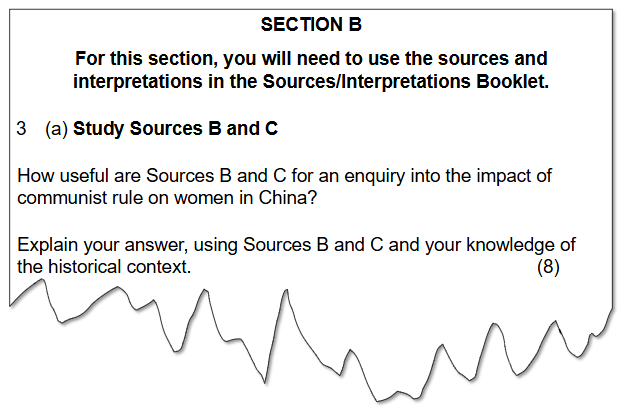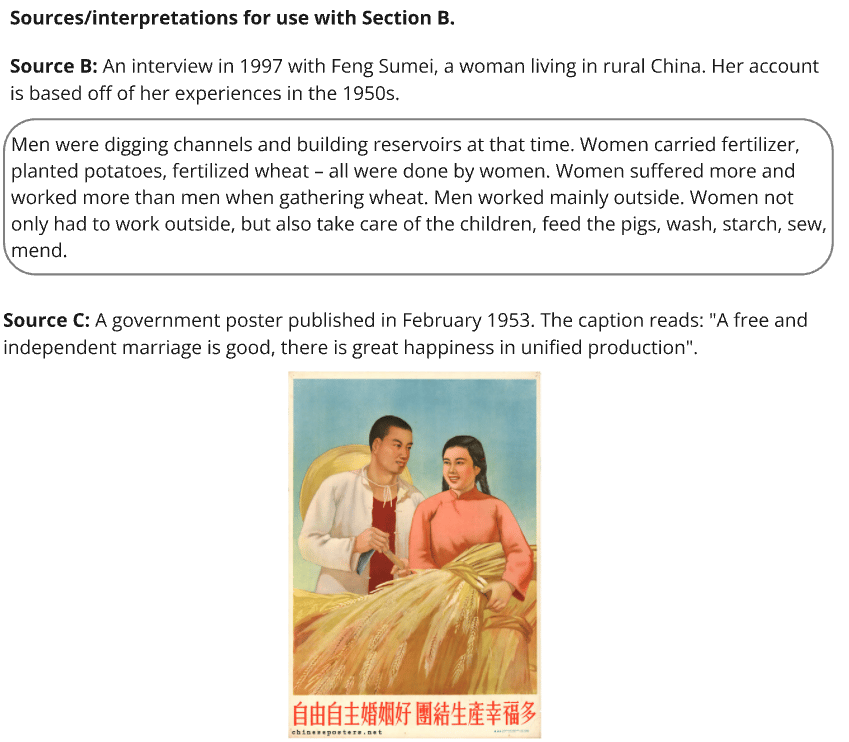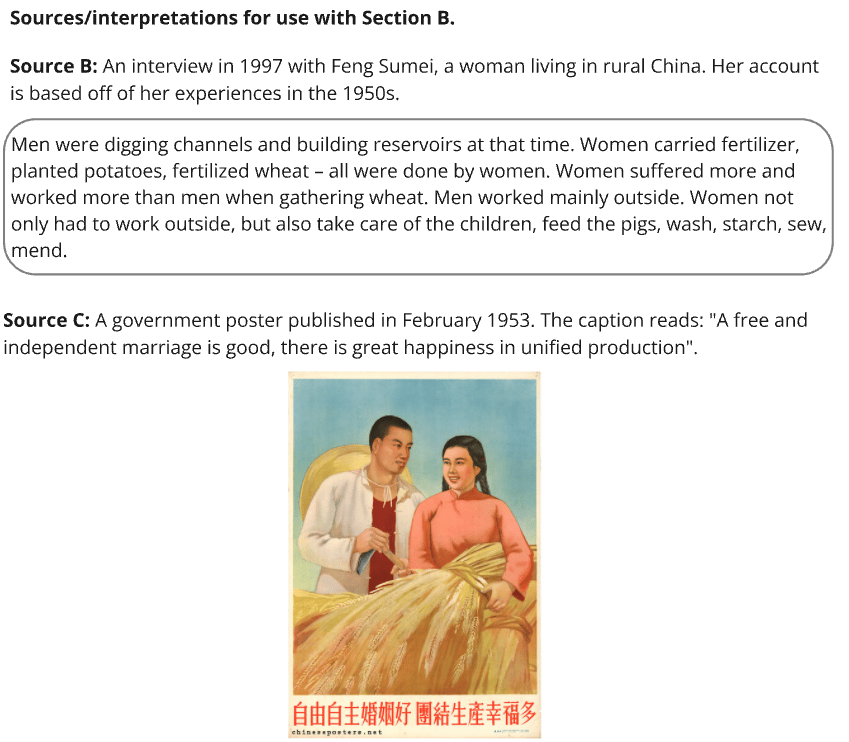The 8 Mark "How Useful are Sources B and C" Question (Edexcel GCSE History): Revision Note
Exam code: 1HI0
Summary of Question 3 (a)
Question 3 (a) requires you to evaluate how useful two sources are for a historian investigating a specific issue
You should:
Refer to the content and provenance of the sources
Use relevant own knowledge to support your points
Make a clear judgement on how useful each source is for the enquiry
This is the first question in Section B of the paper
Questions 3 (a) to 3 (d) will be based on the same topic
Amount of marks | 8 |
|---|---|
The time that you should spend on the question | No more than 15 minutes 5 minutes of planning 10 minutes of writing |
An example of the type of question you may encounter can be seen below:

In previous years, this question has focused on the following topics in Mao's China:
Year of Exam | Question Topic |
|---|---|
2018 | Reasons for the success of the CCP in the Civil War (opens in a new tab) |
2019 | The effects of the Cultural Revolution (opens in a new tab) |
2020 | Achievements of the First Five-Year Plan (opens in a new tab) |
2021 | No paper available |
2022 | Causes of the Great Famine (1958–62) (opens in a new tab) |
2023 | Reasons for the Cultural Revolution (opens in a new tab) |
2024 | Healthcare reforms in Mao’s China |
What is a historical enquiry?
A historical enquiry is when historians ask questions, select evidence and make judgements about the past
All questions in Section B — Questions 3 (a) to 3 (d) — will be focused on the same historical enquiry
If you do not link your answer to the enquiry in the question, you cannot score more than 2 marks
Using the content and provenance of a source
A historical source is made up of:
The provenance
The background of the source
The content
The information the source shows or describes
Provenance
The provenance appears at the top of each source and usually tells you:
Who created it
What type of source it is (e.g. a diary)
When it was produced
Where it was created
For the example question, here is a breakdown of the provenance of Source B:
Who | Feng Sumei, a woman living in rural China |
|---|---|
What | An interview |
When | 1997 |
Where | China |
How is provenance important for a "How useful…" question?
Use the provenance to consider:
Is the source typical of what you would expect the author to say or show?
Is the source accurate if it was produced years after the event?
What factors could have influenced the author's opinion?
Content
Finding the content of a source depends on the type of source you have
Written sources
Read the text closely to understand what it tells you about the issue in the question
Look for:
The author’s overall viewpoint on the enquiry
Key quotes about the enquiry
Visual sources
Look carefully at what the image shows
Ask yourself:
What is happening in the image?
Who or what is included or left out?
What message is being communicated?
Is anything staged or exaggerated?
How is content important for a "How useful…" question?
Use the content to:
Make inferences about the enquiry
Provide evidence for your judgement on the source's usefulness
Making judgements in a “How useful are Sources B and C?” question
The 8 mark "How useful” question requires you to make a judgement
Common mistakes in judgement questions
Saying that neither source is useful
Avoiding a clear decision by using phrases such as “kind of” or “maybe”
Focusing on reliability rather than usefulness
All sources are useful for a historian, but not all sources are reliable
A speech by Mao is likely to contain incorrect information and be biased in favour of Communist ideals
However, it tells historians about how the CCP communicated its policies to the public
What makes a good judgement?
Refers to specific content from the source
Uses the provenance clearly
Applies relevant contextual knowledge
Links back to the focus of the question
For the example question, the focus of the question is the impact of Communist rule on women
The limitations of sources
Your judgement does not need to include limitations to get full marks
Students’ responses are often given higher marks if they only focus on the source's strengths
However, if you include a limitation, you must make sure the limitation is:
Supported by knowledge
Focused on the question
Relevant to your answer
“How useful are Sources B and C?” question structure
You will find Sources B and C in the Sources/ Interpretations Booklet
Do not use Source A for this question
This source is only relevant to Section A
It is not included in the insert

Your answer should include:
An explanation of how useful each source is for the enquiry
Use of content and provenance
Specific and accurate own knowledge
Your answer could be written in PEE paragraphs
P — Make a point about the question
Make it clear how useful the source is
Use the source to make an inference about the issue in the question
E — Use information from the source and knowledge to support the point you have made
Your knowledge should be specific
E — Explain why this shows that the source is useful
Focus on the given issue in the question
To get full marks, your judgement must use:
The source's content
The source's provenance
Your own knowledge
You will need two paragraphs
The focus of Paragraph 1 should be Source A
The focus of Paragraph 2 should be Source B
You will achieve 8 marks for your analysis and evaluation of how useful both sources are for the enquiry (S)
Worked example of a “How useful are Sources B and C?” question
Worked Example
3 (a) Study Sources B and C.
How useful are Sources B and C for an enquiry into the impact of Communist rule on women in China?
Explain your answer, using Sources B and C and your knowledge of the historical context.
(8)

Answer:
Source B is useful for showing the real experience of rural women in the 1950s under Communist rule (S). Feng Sumei describes how women "suffered more and worked more than men" (S). From my own knowledge, I know that during the Great Leap Forward (1958–62), women were expected to work in the communes while also managing the home. The government's aim to increase female labour resulted in women doing both physical labour and housework, which caused difficulties (S). The source is useful because it shows the gap between Communist promises and real life from a woman who experienced these changes. However, it is an interview from 1997, many years later, so memories may not be completely accurate (S).
Source C is useful for showing how the government wanted to portray women’s roles in the 1950s (S). The poster was published in 1953 and promotes “a free and independent marriage” with an image of a happily married young couple (S). From my own knowledge, I know that the 1950 Marriage Law was introduced to ban arranged marriages, allow divorce and give women more rights within marriage. This meant that women ideally became more equal partners in marriage (S). Therefore, Source C is useful because it is an official poster, showing how the CCP communicated the ideas and changes to women's lives. However, as a propaganda poster, it may not reflect the difficulties women still faced in rural areas (S).

Unlock more, it's free!
Did this page help you?